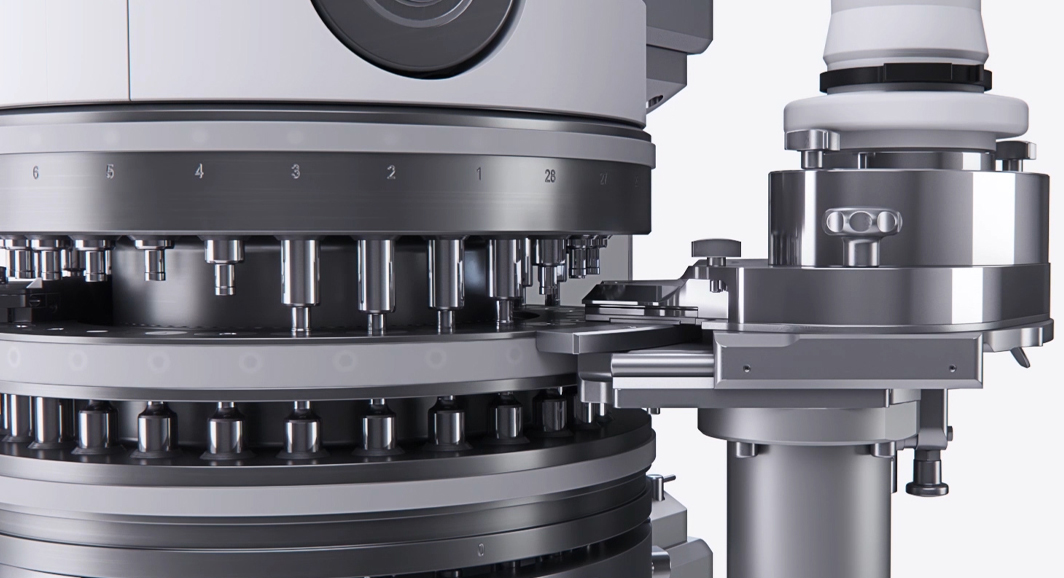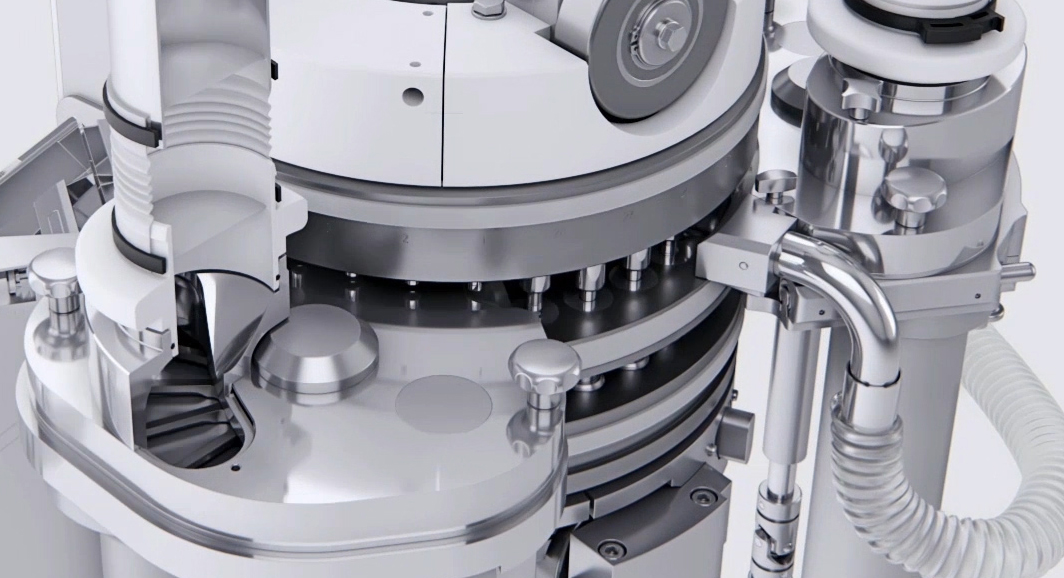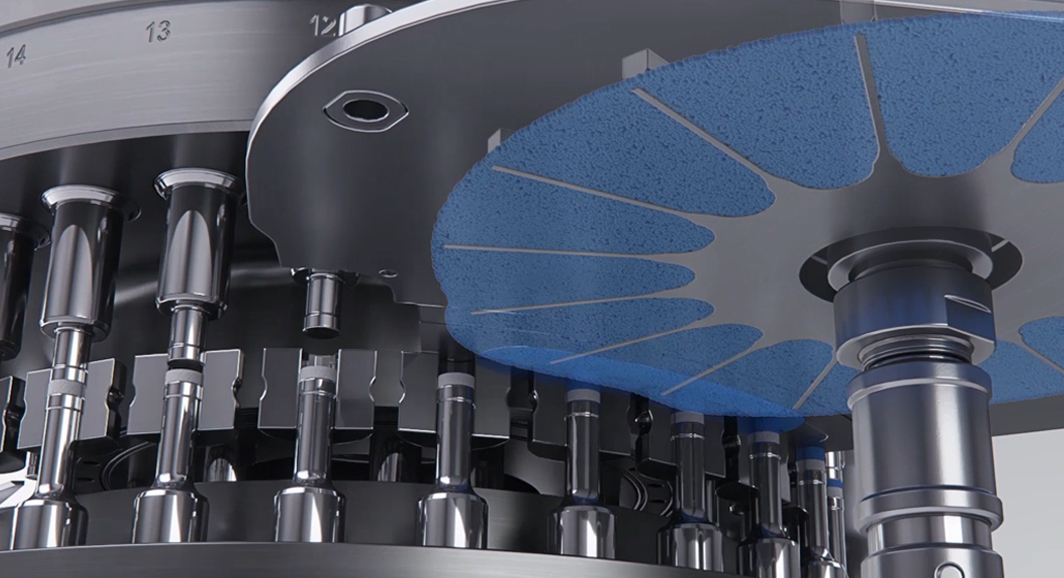Key Considerations in Multilayer Tableting
The addition of further layers in a tablet creates several complexities. For example, the previous layer has to be prepared in such a way that it allows bonding with the next layer while having a perfect separation line between the layers. Filling of the next layer has to be done without pulling down the lower punch during this step as is the case in a classical compression cycle using a filling cam. In addition, the product dosed out of the feeder must not be recirculated, otherwise cross-contamination would occur between layers. The individual weight in each layer must be regulated, while having several layers in the die.
There are several key considerations in the manufacturing process of multilayer tablets.
Filling. The filling of the first layer is classically done using a fill cam that pulls the lower punch down, but for the second and subsequent layers, it is only the upper punch penetration at the tamping stage of the previous layer that creates space inside the die. This space is then used to fill the next layer. It is not possible to use a fill cam after the first layer, because the tamped first layer may remain in place in the die due to radial die-wall forces. For this reason, the upper punch penetration is required to make space in the die and to push the tamped first layer deeper in the die to facilitate the next layer fill.
Tamping. A low tamping force, between 100 N and 1000 N, is typically applied to the intermediate layers with a minimum densification effect, so that a flat surface is created for the next layer filling space. The tamping force is then used for the weight regulation of the corresponding layer.
Layer separation. There are different ways to keep each layer from passing into the next layer feeder. The best way is to contain the material in each feeder and to incorporate an integrated dust extraction nozzle to capture any fines or residue that may escape each feeder.
Weight control. Final tablet weight is controlled by the main compression force. Single-layer weight control is based on the same principle, but it is adapted to the tamping forces and single-layer sampling. Due to lower forces applied when tamping multilayer tablets, the force measurement transducers may need to have increased sensitivity.
Layer sampling. How can we sample a single layer if it is only tamped (not tableted) and the compression cycle has not finished? Intermediate layer sampling can be achieved by increasing the tamping force during sampling to produce a sample that is hard enough to permit a weight measurement. Some tablet presses can eject every single layer through an additional outlet channel located just after tamping. Others are equipped with retractable feeders, and the layer is ejected through the general discharge chute. In this case, the layer hardening is executed at the final compression station, and the tamping force remains under automatic control during layer sampling.
The following process parameters are crucial in multilayer tableting:
Turret speed. The multi-layer compression cycle is more complex than that for single-layer tablets and, thus, requires a very precise setup. Turret speed and the related dwell times for filling and compression are, therefore, critical parameters for achieving the targeted layer weight and hardness.
Filling. The time and space dedicated to the filling of the successive layers are more limited than when manufacturing single tablets, and there is limited fill space for the second and subsequent layers. All parameters related to the filling of the different layers are, therefore, critical for achieving weight uniformity of the layers and final tablets. The feeder paddle configurations and speeds of the successive feeders, as well as the settings of the upper punch penetrations, will greatly influence the ability to achieve target parameters (weight uniformity and hardness).
Tamping force. A tamping force study is generally recommended to establish the maximum force at which delamination (i.e., layer separation after tableting) will occur. The maximum force is balanced on the low end by the force necessary to create a clear and horizontal dividing line between the layers. Due to lower forces applied when tamping, the force measurement transducers may need to have increased sensitivity.
Vacuum for layer separation. Effective layer separation is crucial for multilayer tablets, not only for aesthetic reasons, but also for chemical and pharmacological purposes (such as incompatibilities between the APIs, the different release profiles, etc.). The vacuum should, therefore, be high enough to avoid any cross-contamination between the layers but not high enough to adversely impact the production yields. Excessive dust extraction may also impact layer weight uniformity.
What are the solutions available for addressing the typical challenges in the production of multilayer tablets? The important thing is to achieve enough upper punch penetration to produce the required layer weight. There are upper punches adapted to multilayer compression (i.e., the upper punch tip has to be longer than the maximum insertion depth, while the lower punch and the die are the same as for single-layer tableting). There are also some tablet presses with a ‘deep fill’ option.
There’s also the need to achieve the right flow of the different layers with less space and time to fill the die. For this requirement, there are several configurations of feeders available.
Low tamping forces have to be measured with high accuracy. In this case, special compression rollers with strain gauges adapted to low force range are available.
Manufacturers also have to address delamination risk. The formulation and lubrication with excipients especially adapted to multilayer applications play a key role in avoiding delamination risk. The right setting of tamping force and the possibilities to increase the dwell time will further help.
And lastly, steps should be taken to avoid cross-contamination between two or more different products handled at the same time in the same machine. This can be prevented by special execution of the feeders with a sealing of the gap between feeder plate and die table, optimized die table scraping, and dust extraction before each feeder.
What are the solutions available for addressing the typical challenges in the production of multilayer tablets? The important thing is to achieve enough upper punch penetration to produce the required layer weight. There are upper punches adapted to multilayer compression (i.e., the upper punch tip has to be longer than the maximum insertion depth, while the lower punch and the die are the same as for single-layer tableting). There are also some tablet presses with a ‘deep fill’ option.
There’s also the need to achieve the right flow of the different layers with less space and time to fill the die. For this requirement, there are several configurations of feeders available.
Low tamping forces have to be measured with high accuracy. In this case, special compression rollers with strain gauges adapted to low force range are available.
Manufacturers also have to address delamination risk. The formulation and lubrication with excipients especially adapted to multilayer applications play a key role in avoiding delamination risk. The right setting of tamping force and the possibilities to increase the dwell time will further help.
And lastly, steps should be taken to avoid cross-contamination between two or more different products handled at the same time in the same machine. This can be prevented by special execution of the feeders with a sealing of the gap between feeder plate and die table, optimized die table scraping, and dust extraction before each feeder.



